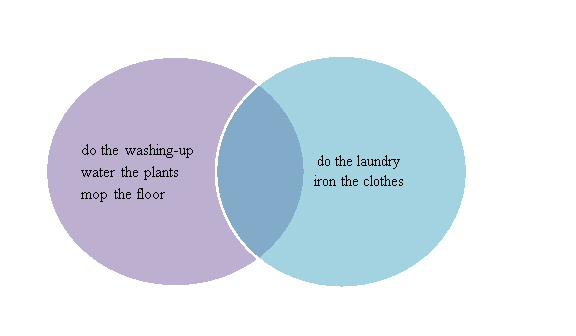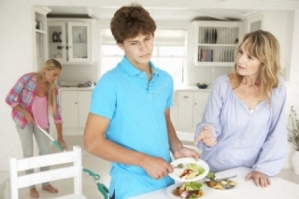Урок " Робота по дому"
Theme: Household Chores
Procedure
I. Introduction
T: Good morning, pupils. Nice to see you again. I think you are OK and get ready for the lesson.
Ps: Good morning! Nice to see you too.
T: Today we continue to speak about duties in your family.
You’ll revise vocabulary and grammar related to the topic, practice your speaking, reading and writing skills, work in groups and pairs.
By the end of the lesson you should be able:
to identify main ideas and details from the text for reading;
to participate in common conversational exchange about the topic of today`s lesson;
to operate lexical material of the topic in new situations.
I believe, you`ll be active and work hard during the lesson.
Pupils, if you want our lesson to be interesting, you need to predict your answers at the lesson.
P1. At the lesson I will be a rainbow. My answers will be vivid and diverse.
P2. At the lesson I will be a cloud. My answers will be quick.
P3. At the lesson I will be the sun. I will be creative.
II. Warming up
T : Look at the picture and guess what is in the other half of the picture. (Teacher hides a half of the picture and students asking yes/no questions have to guess what is depicted there).
1. Is the girl sweeping?
2. Does their mother get upset? so on
III. Revising the vocabulary
1. T: Imagine that you are living in a house together. Doing chores is a tradition in your family. I want to know how many household activities you know.
The group is divided into two teams. Teacher sets the timer for 3 minutes and shows a card with a written word to one student who has to explain this word to his team. When he does it the next student comes up quickly to the teacher and starts doing the same. The team which guesses more words wins.
Cards to explain
|
beat the rug dust the furniture sweep the floor vacuum the carpet set the table do the washing-up iron the clothes take out the garbage make the bed do the laundry |
cook do the shopping take pets for a walk fix things pick ripe fruit water the plants mop the floor hang out the laundry clean the windows polish the shoes |
Keys:
Beat the rug - to dust out the rug when it is dusty and dirty.
Dust the furniture- to clean the layer of dust that settles on the furniture.
Sweep the floor - to clean the dirt or litter on the floor with the help of a brush or a broom.
Vacuum the carpet - to clean a dirty carpet with a vacuum cleaner.
Set the table - to prepare a dining table for the meal.
Do the washing-up- to clean the dirty dishes after dinner.
Iron the clothes - you need to do it when the washed clothes are dry.
Take out the garbage- you need to do it if the dustbin is full.
Make the bed - you need to do it after you get up in the morning.
Do the laundry - you need to do it if your clothes are dirty.
2. Game “Categories”
The learners work in two teams to think of five words for another team to guess - the harder the words are, the less chance they have of guessing them!
Each team has а different category, e.g. “Household Chores” and “Activities in the class”. The learners write five words from their category, e.g. do the washing-up, do the laundry, iron the clothes, make the bed and dust the furniture.
When both teams are ready, team А reads out their category and team В has one minute to guess the words the other team has chosen.
For each correct guess team В gets one point. For each word that is not guessed, team А gets one point! (The five points are shared between two teams.)
Then team A turns to guess words from team B's category.
Teacher: Well done! I see that you know a lot of household activities. Many people find chores unpleasant or boring and are reluctant to do them. However, when chores are divided between many people they can be accomplished much faster.
IV.Reading
Pre –Reading
- Do you like doing housework?
- What chores do you usually do?
- What are your mother’s / father’s responsibilities?
- Should children do the chores? Why?
- What chores can they do?
- How often do you do them?
- Do you avoid doing chores?
- Do you like to clean up your room?
- Do you wash clothes for your family?
While- Reading
T: Look at the first line of а story in the paragraph below. Then look at the paragraph headings and write the sentences in the box in the correct order and in the correct paragraph.
|
As а result, I walked mud all over the carpet. They were on holiday in Italy. Then I decided to water their plants.
They never knew what problems I had had.
Their flat always looked clean and beautiful.
|
Paragraph 1: Beginning of the story and background
1. My friends asked me to look after their flat while they were away.
2. ....................................................................................
3......................................................................................
Paragraph 2: Main events of the story
4. Things soon started to go wrong.
5......................................................................................
6. ....................................................................................
7. ....................................................................................
8. ....................................................................................
9. ....................................................................................
Paragraph 3. What happened in the end/the conclusion
10.....................................................................................
11. ...................................................................................
Post-Reading
Where were friends on their holiday?
What kind of chores did the boy do?
Did he manage to clean up all the mess?
V. Practising grammar
T: Read through the rules in the grammar box.
|
Positive |
|
|
|
I/You/We/They |
have to |
put all the DVDs on the shelves. |
|
He/She/It |
has to |
work. |
|
Negative |
|
|
|
I/You/We/They |
don’t have to |
put all the DVDs on the shelves. |
|
He/She/It |
doesn’t have to |
work. |
T: Have to implies a certain obligation to do something, and don’t have to implies a lack of obligation to do something
Writing
Complete the sentences with the correct form of (not) have to.
1. My room is so untidy. I........ (tidy)it up.
2. There’s a problem with our car. My father.....(take) it into garage
3. It’s your birthday on Sunday. We........ (go) shopping.
4. Our dustbin is not full, you..... (take) out the garbage.
2. T: Now let’s play a game using have to or don’t have to.
Game “Change places if ...”
The learners sit on the chairs in а circle. They jump up and change places if the statement is true for them but they have to be quick, as there are not enough chairs!
The teacher says (for example):
T: “Change places if you have to iron the clothes every day”. All learners who have to iron the clothes every day stand up and move to another chair and the teacher should sit on one of the chairs. The person without а chair stays in the middle and gives the next command (for example): “Change places if you don’t have to vacuum carpets every day.”
VI. Pair work
Teacher gives out a blank Venn diagram to each pair and asks them to talk together and to fill in several things for each space on the diagram. To do this they need to ask each other questions. Questions could include: Do you have to do the washing-up? Do you have to do the laundry? etc.
After that each pair introduces the information. For example: I’m Ann and this is Kate. We both have to sweep the floor. I have to do the washing-up and Kate has to do the laundry.


Home Assignment
Write a paragraph on your usual work about the house/flat.
You have to make the computer presentations on the topic “How I help my parents”.


про публікацію авторської розробки
Додати розробку

